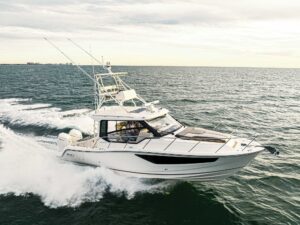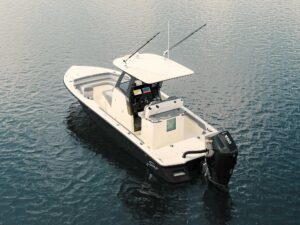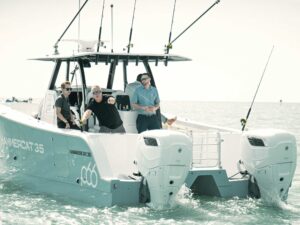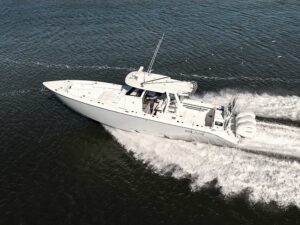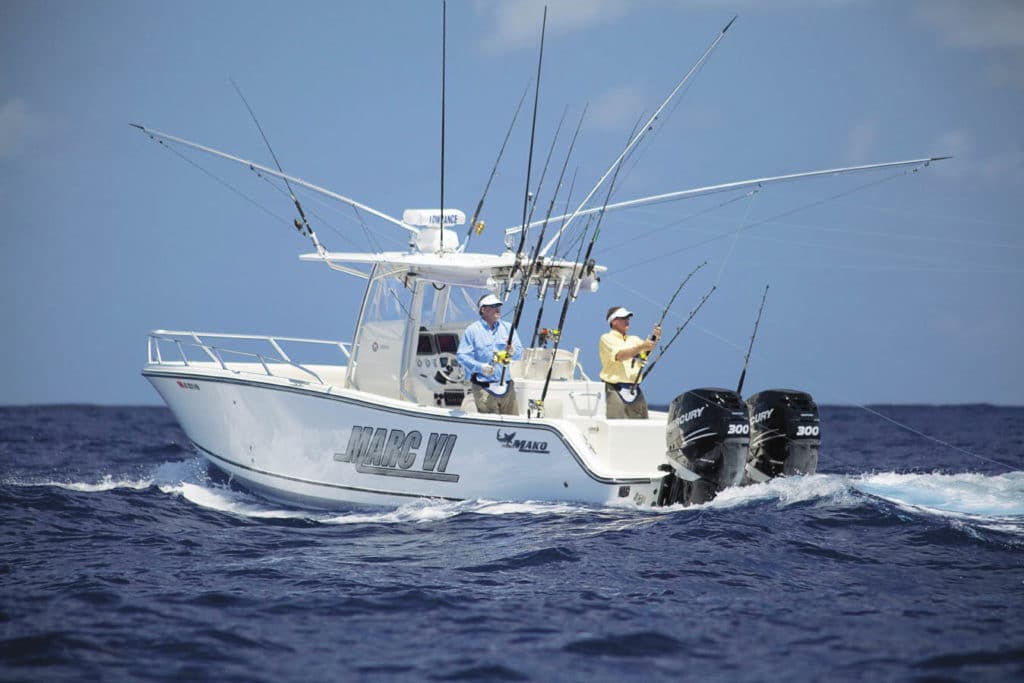
Big Fish Small Boat
Hooking, fighting, and beating a blue marlin, swordfish, big tuna, large wahoo, monster shark, or any impressive offshore fish aboard a center console is quite an accomplishment. When that trophy lies alongside the boat, inches away from you, it’s an unforgettable, eye-opening experience!
We’ve enjoyed spectacular battles with just about every pelagic species in southern waters. And each encounter is just as exhilarating as the last. Like other hard-core, center-console offshore anglers, we’ve refined our tactics over the years, so we’re successfully raising and hooking more trophy fish, as well as fighting and beating them in a efficient, well-thought-out fashion. Here are our tactics aboard my MARC VI.
Cheated-Up Reels
While large sport-fishing boats can back down after a powerful fish, center-console boats can’t duplicate that feat, especially in rough seas. Instead, we give chase from the bow, often with limited hands to clear rods and the cockpit. Therefore, a bit more time is required to clear teasers, dredges and remaining outfits, and position our angler to give chase.
When trolling for a huge fish like blue marlin, extra line capacity is advantageous, as it allows extra time to set up a bow-first pursuit. For example, when we’re dialing in on blue marlin, I’ll use my Penn 50 Wide Internationals filled with 80-pound braid, followed by a 150- to 200-yard top shot of 50-pound monofilament; My Penn 70 Internationals are filled with 100-pound braid and a 150- to 200-yard top shot of 80-pound-test monofilament. The small-diameter braid enables line capacity to jump from a standard 800 yards of mono to well over 1,200 yards. You’ll likely never need that much line, but it’s good to have it, just in case.
This tactic is ideal with 30-pound tackle for big tuna, billfish or sharks: Spool up with 50-pound braid and a 150- to 200-yard, 30-pound mono top shot.
Set That Iron
To solidly plant the hook, you must first overcome the stretch in monofilament line. When setting up on a fish, we’ll troll straight ahead at the same speed for at least 30 to 45 seconds.
The running fish, combined with the forward motion of the boat, eliminates most of the stretch in the monofilament to provide a solid hookup. Another advantage to maintaining course and speed is the remaining baits stay in play, perhaps enticing a second or third fish. Shifting immediately into neutral after hooking up thwarts hook-sets, and unplugs the bait spread.
Clear the Arena
We joke that the person fighting the fish, no matter how large, has a less strenuous job than the person clearing the cockpit. This is especially true aboard our boat, as we often troll two surface teasers and two large dredges, and a minimum of five outfits.
Everyone has a role, even if it’s just me and a friend. Upon slowing the boat to fight the fish, the drill is to wind in lines that could interfere with the hooked fish, followed by teasers, close lines, and dredges. Rods are racked, teasers removed or wound up out of the water, and dredges stowed. The goal: a clean ocean in which to fight the fish, and a clean cockpit from which to fight and wire the fish.
Battle Smartly
With most fish, the successful strategy is simply keeping the angler facing their quarry, and occasionally bumping the boat in gear to keep a tight line. We’ll occasionally crab backward to help our angler regain line, if needed.
When we hook a powerful, long-running fish, I’ll maintain speed for 30 to 45 seconds, then slow the boat and pivot halfway around to the fish, but not enough to run over the uncleared lines. I’ll put the angler alongside the console, and then slowly motor toward the fish, while the cockpit and lines are cleared.
We strive to contain the fight to the first third to half of the reel’s line capacity, and keep our angler tight to the fish. By chasing a fish from the bow, we retain maneuverability and forward progress, especially when in rough seas.
When the fish beelines into the depths, we’ll motor up on it, reclaim line, and maintain a vertical angle; the angler remains amidships if we believe the fish has enough power to come up and make another long run.
Critical points during the fight include backing off the drag during long runs and then advancing the drag back to the original fight setting when the fish is close.
End of the Line
The endgame should find the fish settled and within a hundred yards of the boat, then the angler moves back into the cockpit. The final 100 feet are the most crucial. I’ll often engage the autopilot to hold a straight course, and put just one outboard in gear. This keeps the fish swimming toward the angler, who is pumping and winding it closer. I’ll adjust the speed and direction of the boat if necessary. When the leader is taken, or gaff sunk (tuna, big dolphin, wahoo), the angler should back halfway off the drag to prevent a pulled hook or broken line if the fish surges. Should that occur, wait until the fish settles, then advance the drag to the fighting pressure, and repeat the steps above until the fish is fully subdued.
Safety First!
Pursuing large big-game fish aboard a center console calls for stand-up tackle. If you strap into a harness with heavy tackle, be safe.
- Keep a spotter behind you ready to assist should you slip or fall backward when the hook pulls or the line breaks.
- Use safety lines from the reel to the boat, at the very least, and preferably from the back of the harness to the boat.
- Keep a cutting device, one that can easily slice through braid, secured to your harness with a cord.

